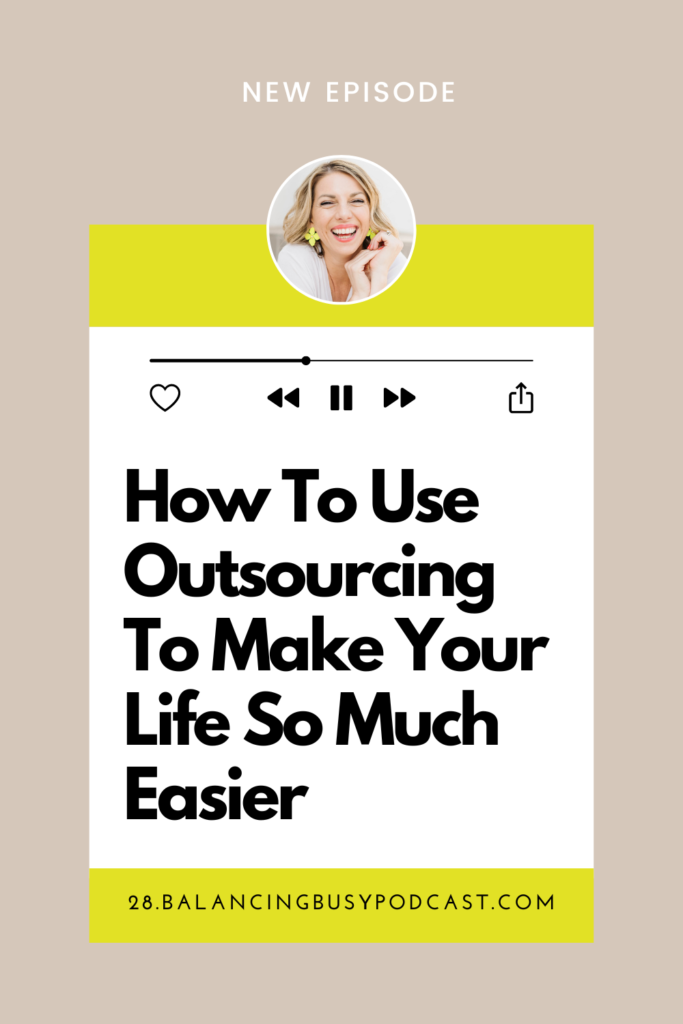Hello, I am Leah Rela and this is The Balancing Busy Podcast, and today we are going deep, deep, deep dive. In fact, I’m actually giving you access to one of my trainings that I have. Never shared in this form where it’s just available for everyone, but I’m so excited. It is called Outsourcing Explained, and one of the most incredible ways I know of to balance the busy is to get help from others, but I get it.
[00:01:01] That can feel so intimidating and daunting, so I am sharing. , all of it. My process where I’ve failed, where I’ve learned all the nitty gritty on how to outsource this is outsourcing explained. Now, I did this training a couple years ago, so I’m doing something a little bit fun in this particular episode.
[00:01:21] First of all, it’s two parts. There’s gonna be part one and part two. Second of all, I’m going to interject from time to time and just share thoughts that I have now today in 2023, so I’m gonna add that in there as well. So, without further ado, let’s jump right in and let’s start listening to outsourcing Explained.
[00:01:39] Oh, I should probably say you might want a pen and paper for this one if that’s not possible, cuz you’re driving. That’s okay. Just soak it all in. But this might be one you wanna take notes on. Okay. Now we’re jumping in.
[00:01:52] So I created this training originally in 2012, 2013, and was teaching outsourcing. And, and it came from this concept of it was really scary to outsource in the beginning. I waited a really long time, way too long, and I’m gonna go into that. There were so many reasons I’ll share all that, but I just, I got stuck.
[00:02:12] I got stuck in the fear cycle and, oh, I don’t feel like I can afford this. I can’t justify this. Um, I don’t know how to do this. Just all of those things. It really, it blocked me for a really long time. And then I finally did it and I actually saw my income grow, which was crazy, right? Like the biggest fear I had was, I can’t afford this.
[00:02:29] And by finally doing it, I made more money. I’m like, why wasn’t I doing this sooner? And I saw this over, over, especially as a speaker going and, and speaking. And one of my favorite things about when you go and speak, at these different conferences and, and conventions and workshops is, is at night. It’s, it’s the evening when everybody’s done and everybody just kind of comes around and starts talking and sharing and, and the guard comes down and, and, and women just start, just start being vulnerable and start admitting like, here’s what’s going good, but here’s what’s not going well.
[00:03:03] And overwhelmingly the thing that women are struggling with is balancing it all is, is managing it all. And, and I have whole trainings and do whole things around balance and productivity and, and all those things. But there is a key component to this, which is getting help. And so that’s where this comes into place.
[00:03:21] It’s the okay, but how, how do you get help? How do you outsource? What can this look like? Is it as complicated as I think it is in my head?
[00:03:29] So let’s do it. Let’s jump in. Outsourcing explained this is to teach you how to start outsourcing. I wanna show you that it’s simpler than you think. I wanna show you ways that maybe you haven’t thought as could be. Forms of outsourcing that are actually really, really simple. And I want to just. Break this down.
[00:03:46] So we are gonna talk about like, how do you even put it out there that you’re hiring? How do you create a description? How do you interview someone? How do you build the training material when you don’t even feel like you have time to find someone lo let alone like, make the training material. Um, how do you, like, how do you be a good boss?
[00:04:03] And I’m just gonna tell you, I did so much of this wrong in the beginning, so, so much of it wrong. Like I probably still have apologies that I need to go make because I was learning, I was trying to figure it out. I I didn’t know how to be a good boss, a good manager. Um, and, and so I wanna share with you like the, the crappy mistakes I made, the things I’ve figured out, the things I feel like I’m doing better.
[00:04:24] I just wanna show you the whole process so that you can take this and, and implement it into your own business. So the first thing, let’s. Like talk about why, why outsource, why, why is outsourcing important? I’ve got 10 reasons for you, and I hope by the end I have you convinced that like, yes, outsourcing is really important.
[00:04:45] Okay, number one, to improve and protect your relationships. This was my recent, this is why I finally did it. So I had been working for probably about two years.
[00:04:55] I was, um, our sole provider and my kids were really little, I mean, None of ’em were in kindergarten yet. And, um, I was trying to do it all it, and it was hard. I had, you know, nap time that I would try to use, but it honestly felt like nap time got shorter and shorter every time. Um, I would try to work, you know, during these little pockets.
[00:05:17] I never quite knew when they were coming. It was, it was really hard. And so I started working at night. I would put them to bed and I would go work at night and I realized that I could basically go two, three nights without sleeping, or only sleeping an hour or two. And then I would get one night of sleep and then I would do it again.
[00:05:37] And I, I thought, oh, look at me. I figured it out. I’ve like cracked the code. I had not, um, everything was falling apart. Like the only thing that looked like it was going great was my business. And it was really exciting to, to be reaching these income levels and these different, these different things there, but everything else felt horrible.
[00:05:57] One of the things I remember is, That house that we lived in at the time from my office door, I could see into our bedroom and my husband would often say, Hey, do you wanna watch a movie or, you know, a show or something like that. And I would be like, oh yeah, gimme 30 minutes. And, and as I was working, it was always, it always took more time than I thought it should, right?
[00:06:17] I thought, oh, I’m gonna be done in 30 minutes, 30 minutes. I’m like, I’m not even close. And so I keep working. I keep checking and looking and checking and looking and, you know, he’d still be up, he’d still be waiting and, and without fail, I would check to look and he had fallen asleep. And over and over he would have to fall asleep waiting for me because I never showed up.
[00:06:38] Um, also, I had a really hard problem because I worked from home, um, staying off of work when I wasn’t supposed to be doing it. It was right there, it was accessible. And that was like, that was. 10 years ago. I mean, now it’s even more accessible. Smartphones make it all so much easier. That was still new, um, when, when I was first starting.
[00:07:04] And so I would, I would find myself sneaking into my office all the time to combat that because it made me feel like the world’s crappiest mother. Um, I would leave the house. I, I knew that if I left the house, then there was no opportunity to get distracted. So I would take the kids to all these places.
[00:07:21] Um, the, we lived in Portland, Oregon at the time, and I would take ’em to the forestry center and this, um, children’s museum and the zoo and, and I would rotate these every Wednesday and I would take them and, and try to deal with some of my mom guilt by taking them to do something fun for, for a few hours.
[00:07:37] Um, one of those times I was at the zoo, we were looking at the alligators. It was warm and stuffy in that little like area that’s enclosed and I started. My hearing was going out. Everything was going black, and I knew, I knew I was about to lose consciousness when I woke up. I was on a stretcher. Um, and being put into an ambulance and leaving my three still in a stroller, children at the zoo alone, it was, um, a moment that still haunts.
[00:08:14] And it was the moment where I vowed to fix things. I vowed to figure out a better way because I needed to protect these relationships. I had this moment once where I saw my husband fall asleep, and just this little, the, that little inner voice that prompting that feeling was. What would you do if he stopped waiting for you?
[00:08:35] And, and I just, I couldn’t, I couldn’t gamble like this anymore. I couldn’t take these risks and so I, I had to fix things. And one of the ways that I did that was through outsourcing. So improving and protecting your relationships. That, that was mine. Um, that was my reason. Okay. Little, little more lighthearted.
[00:08:51] Now, why else? Because you can save a lot of time and your time is valuable and you need to see your time as valuable, um, because you can get more work done, but you get the right work done. What’s so cool about outsourcing is you start looking at what are the tasks that actually make me money, like I make the most money when I’m doing this.
[00:09:07] Great. Do more of that and let somebody else do the other stuff so that you can do more of the money making stuff. Um, which brings us to number four. You make more money. I was so scared of outsourcing for so long because I felt like, oh my gosh, I can’t afford it. When I finally outsourced, I started making more money.
[00:09:25] It was crazy. And all that time, all that time I was spending, I mean, just a slave to my computer and trying to get all this done. , I was freed up. It was insane. I, I could not believe I went from, I don’t know, you know, obviously I didn’t track cuz I did not wanna know how many hours I was spending, but easily, easily 80 plus hours a week.
[00:09:45] I went down to between 15 and 20 and I increased my income. Like, I mean, I was, it was mind blowing. I’m like, oh my gosh, I’m making more money. And I’m like, cut my hours more than half. And it was because all sudden I could take on more clients because I wasn’t doing all of that busy work. I let somebody else do it, which meant I could take on more.
[00:10:05] It was incredible. And all of my businesses, I had different divisions I can share about that later. But everything grew. So I really believe like you can make more money, which is so exciting. It creates opportunities for faster growth, reduces the overwhelm and the stress. You get to do more of what you love and what you’re best at. One of the things is really recognizing this is not in my wheelhouse. This is not my strength. I shouldn’t be doing this. This is, and then you, you start doing and working towards those things that really are in, in your wheelhouse and are your strengths.
[00:10:36] Because honestly, other, other people are better qualified than you at some things. That’s just the truth. We have this feeling of like, no one can do it as good as I can. Mm. There’s people who can do it better than us. It’s just true. Um, and it’s a low, it’s low risk in comparison to hiring employees.
[00:10:50] And I’m gonna, I’m gonna walk you through what that means and what that looks like, but it really is so much lower risk. To start outsourcing and then it improves your customer’s experience. If you are one of those people where you are like, oh, oh yeah, I have the best intentions to follow up to make this stuff happen, and I am getting in the way, I am the problem, you can massively improve your customer experience because you are no longer the one in the way and somebody else is accountable for getting things done and reaching deadlines, and they’re doing a lot better job than you.
[00:11:25] Uh, so there you go. There’s a whole bunch of reasons why you should outsource. . Okay, so what is outsourcing? All outsourcing means is you’re just gonna allow someone else or thing.
[00:11:34] I’ll explain what that means later to help you do some of the heavy lifting. That’s what outsourcing is. You’re letting someone else or something else do some of the heavy lifting for you. Okay. So. That, that sounds okay, right? Like, so far, so good. So outsourcing does not look like one thing. It’s, it’s when you buy a template or a script or something pre-made, so you’re not starting from scratch.
[00:11:57] That is a form of outsourcing. So here is my first interjection. Since this was recorded a couple years ago, I thought it’d be fun to come in and just share some updated things that I would maybe tell you now, and being able to see this in real life, how it’s used is really helpful. So I have a client who booked me for two business blitz days.
[00:12:19] Leah: If you don’t know what a business blitz stay is, it’s where I work with you to. Hammer out whatever that thing is that you’ve been meaning to do forever and it just hasn’t gotten done. And we take a day and we do it well. She knows that she wants to transition over her website. It’s time to give it a facelift.
[00:12:37] She wants to switch over to show it. She had already bought the template that she loved, and if she does it herself, it’ll take a couple weeks. A lot of YouTube videos, a lot of hours. She is absolutely capable, but it’s just gonna be a lot of time. Or she. Look to me and have me help her. So she hired me for two business blitz days, and I’m going to go in and do it all for her.
[00:12:58] I’m gonna take her template, her website, bring it all together and launch it in 48 hours instead of what could be a couple weeks. So there is an example right there of this happening in real life.
[00:13:08] Sometimes we’re like, oh, but I could do it myself. You could, you could, but it’s gonna take hours. And we need to start valuing our time as the business owner, as, as more it needs to be more valuable. It can be hiring a long-term employee or a long-term person, but it can also be for shorter projects.
[00:13:30] There’s plenty of times where I’ve hired someone for one single project, like it’s a week. It’s, it’s this short little period of time. I just need you to do one thing for me. Great resources for that are Upwork or Fiber. So whenever you just have like a a one project, it’s a one off type thing. Going there can be really, really great for finding someone.
[00:13:49] You can outsource it. You can have somebody else do it. Boom, it’s done. Um, it can be someone who helps a lot of people. So I’ve had people I’ve hired where they’re only helping me, like they, they are, um, They’re there for, for me and for for my business. And then there’s opportunities where you can hire someone who is doing it for multiple.
[00:14:09] A lot of social media managers are, are handling and managing multiple accounts. So that can be a another way to see outsourcing.
[00:14:17] Um, and obviously it can be fine. Someone that you find, hire, train, and who works only for you. I’m gonna show you what that looks like cuz I think that’s the most intimidating and that’s the one that I am, that I do the most.
[00:14:28] So that’s what I’m gonna be really showing you today. Um, but it can also be things like HelloFresh, grocery deliveries or a private chef. And, and the reason I use that is I wanted to show you three very different examples. So, um, HelloFresh, if you’re not familiar with it, it’s uh, meal planning, food delivery.
[00:14:46] We do it, we love it. We get three meals a week. Each of my kids choose the meal that they wanna make it. A box comes, it’s got all the ingredients, ev and the recipe card inside. And, um, And then they’re in charge of making that dinner. So I even outsource cooking to my kids . Um, so, so that is a form of outsourcing.
[00:15:06] HelloFresh is doing the meal planning. I just pick, Ooh, that looks good. They send everything. It’s already there, measured ready. Um, and then I outsource even deeper by having one of my kids cook it. Grocery deliveries. It’s, you gotta get groceries, but this is a, a very small but, but real way of outsourcing.
[00:15:22] Perfect. Let somebody else go, pick out all the food and drop it off at your house if you happen to live in an area where that’s available. I loved and lived by grocery deliveries for many, many years. I now live in an area where that is not an option. Makes me sad. Um, and of course you could take it to the, the, the top level and have a private chef have someone who comes in and cooks for you all the nights of the week.
[00:15:43] I’ve never gone that far, but I have had somebody who comes in and does cook a couple nights a week. Um, it was actually really fun. I did it in conjunction because one of my daughters absolutely loves to cook. And so this was a beautiful, amazing woman from Mexico and she would teach authentic Mexican cooking, um, to my daughter and they would cook it together and she would, she would take care of dinner.
[00:16:04] So that was really fun. But there is different ways to outsource. So you were gonna pick what works for you, but I wanna show you, like, it could be anything from having your groceries delivered, using Hello Fresh, some sort of service or full on having a private chef in the realm of, I would like to not have to do as much in the kitchen.
[00:16:25] There are some different options just to show you what, what this really can look like.
[00:16:29] Leah: Current me is popping back in. So we started off by talking about why to outsource. Now I wanna transition and get into the how and ultimately I think there are five steps to outsourcing. The first is building your task list, and I’m going to break that down in just a minute. The second is creating your training material, which is not as hard.
[00:16:54] Feels like it is. The third is defining the expectations, which I am going to use a system that I originally learned from, and I’ll break that down for you from Michael Hyatt, who is just so brilliant. Four is finding your team members. Again, not as hard as you think, or at least I thought. The things that really got me stuck was, oh my gosh, how am I supposed to create the training material and how am I.
[00:17:19] Find those people. And then the fifth is establishing a frequent review check-in process. Most of us, what we’re looking for is virtual. There isn’t going to be someone coming to your home if you work from home or coming to work with you face-to-face. So we need to have these check-in processes that make it really work for us to be able to rely and trust someone else and have them feel like they have open communication that they can check back in with us.
[00:17:48] Now we’re going back in.
[00:17:51]
[00:17:51] There’s five steps to outsourcing. Build your task list, create the training material, define your expectations, find your team member, and then establish a frequent review check-in process.
[00:18:03] So let’s go into every single one of these and see what this looks like. So building your task list, my best idea for you is, and this is exactly what I did to begin. For one week, just start documenting all the tasks that you do every day for, for a week. Okay? So have a journal with you. Just, you know, have a notepad and just start writing them down.
[00:18:22] What are all the things you do Now, if, if you like the idea of being able to outsource, um, some of the home tasks too, then do it all. If you like the idea of just your business, then just do tasks for your business. I have outsourced a little bit of everything and, um, and we can talk all about that, but just all I did to begin with is I just started documenting the tasks.
[00:18:42] Okay, what, how do I spend my time? What am I doing? At the end of the week, you’re gonna score them. So they’re gonna get a score between one and three. Number one is, this is something that I absolutely need to be doing. This should not be delegated. Never, never outsource anything to do with your husband.
[00:18:59] Your children and the core things that bring you in money, like your core, you know, this is, this is my gift, okay? Don’t outsource those things.
[00:19:08] Leah: Me again already. I promise not to keep budding in so many times, but I wanna say Don. Negate this idea of documenting your days and your tasks. It is not fun. I’m not even going to lie. It’s totally annoying to do this work and to figure out where your time is going, but it is powerful. It will make the difference.
[00:19:32] So commit to yourself, you know what? I can do this for one week. I’m gonna figure out where my time’s going, and it’s gonna open up so much goodness into your life as you re. Really where you can start balancing the busyness because you start seeing things that you’re spending time on that you just don’t need to be or where a lot of time is being wasted.
[00:19:52] So, I know, I know, I know. I know. This is not fun. I did not enjoy this at all, but it is worth it.
[00:19:59] Um, number two is someone else could do it, but I feel like it would be really hard to train them on it. Okay? So number one is, this is my core competency.
[00:20:11] This is what I’m the best at. This is what lights me up, and this is definitely the most important things. I should not be letting go of this. Number two is, I could let go of this, but this feels really hard. I’m not, I, I can’t quite see how I would let go of it, how I could train on this. And then number three is, yes, this could be done by someone.
[00:20:28] And yes, I think I could train someone on this. Okay, so 1, 2, 3. You’re going to just rank them all. Now, what I found in the beginning was that I had way more ones than twos and threes and way more twos than threes. At this point, it’s reversed. I have way, way fewer ones than I have twos and threes and, and really there’s not really twos, it’s just ones and threes at this point.
[00:20:55] But at the beginning there was a lot more ones and tunes. You, you’re just naturally just, no, you are going to think no one else can do it, but you, it’s gonna be harder to find the threes, but start with something and then you’re gonna get better and, and better at this, I promise. So step two is creating the training material.
[00:21:12] Okay. This, this was the thing for me that was so daunting because the whole reason you need help is that you are overwhelmed. The idea that, oh, and somewhere in all you’re overwhelmed where you don’t have enough time to sleep, eat and breathe as it is. Go ahead. Create a policies and procedures manual and, and training to, to show somebody how to do all this.
[00:21:33] I mean, I just, I could not wrap my head around how in the heck was I going to be able to do this and create all this? And then I figured it out. So what I started doing, and oh my gosh, it’s so much easier now. When I first created this training, it was quite the process to do this. Now, easy peasy. 11 squeezy.
[00:21:53] What you’re gonna do is when you are in the middle of what you are doing, so while you are working, you are gonna turn on screen recording. I use Loom. I love it. It’s amazing. So I, I use Loom. And I just start working and I talk while I’m working. So I’m literally like, here’s why I do this, and here’s what this is about. And here’s, you gotta make sure you do this. And I just talk while I work and I make all these little videos, try to keep ’em around like a five minute mark.
[00:22:20] Just think about this. If you are the person that you hire and you’re like, oh, I’ve gotta figure out how to do this, and they have to watch a 30 minute or an hour long training to find that little part number one, you are paying them for that. And number two, that’s gonna be frustrating for them. Make short little videos, okay, that explain that.
[00:22:39] Stop title it really well so it’s easy to know what it is. And then you start just building this library of trainings. I literally like hack all my trainings by building them in real time. And now I’ve taken that even further where every time we have a project, I just turn on Loom and I’m like, okay, so here’s what I want us to do.
[00:22:57] Here’s what I want it to look like. Here’s why I explain it all. And then I throw it in an email, shoot it out to everybody and there you go. So that is my training material process. It’s really, really easy. I just am using a combination of a Google Doc, okay. So that way everybody can see it, it can be updating in real time.
[00:23:15] It’s easy to keep it there. I can make those little tabs on the side. Um, so a Google Doc that everybody can access. And then I will write out the process, which is really powerful because probably one of the things that’s hard for you is you don’t have a process. You’re constantly sitting down and going.
[00:23:32] How did I do that again? And, and it’s this kind of starting fresh, which is wasting a lot of time by, by doing it as to and while it’s fresh in your head, okay? As like it’s fresh in your head. You just did it. Now sit down and write out the steps really fast. 1, 2, 3, 4, 5, there’s the process. Um, and then you’re creating the training materials by just turning your screen recorder on and talking through what you’re doing.
[00:23:56] You start to have this really amazing just training portal available for your person that you’re gonna hire and future people as they come on. The other thing I would suggest that is really, really helpful is once you do have someone, so I, so this comes later, but once you do have team members and they’re taking on processes and they’re doing things, ask them to build training.
[00:24:19] Material. Ask them, say, I want you to document exactly your workflow, all the steps where you go to get everything, log in material, anything that I would need if I was gonna come in and do this because you were sick or you weren’t available. Um, and then your trading material gets even better and grows even bigger, and they’re helping build it.
[00:24:35] So just store that away, like as you build your team, that is really, really helpful. Um, okay, so what I use Google Doc Loom, Dropbox, slack, zoom, and my team. So what this looks like, there’s a Google Doc that some team members can access, all team members can access. There’s different ones. Then there’s Loom where I’m creating the videos.
[00:24:54] Then I have a Dropbox and I have a team Dropbox. I have Dropbox for individual team members. Um, I have a folder that says Current project, archive project, upcoming projects. And then inside those folders, they’re numbered. So like, you know, zero means this is the, the most important one, and then there’s 1, 2, 3.
[00:25:13] And so they can get a sense of, of where they fall in priority. Um, And I can have a folder that says trainings and then I’m just dropping all the looms in there. And they’re, they’re labeled, you know, they have a good title that makes it easy to, um, to find the one they need for a project. I’ll make a loom just to explain like the overarching, here’s the goal, here’s the why, here’s what I want it to look like, what I wanna do, here’s the inspiration.
[00:25:39] So I’ll make a loom video to show all of that, put that in the project folder itself. Um, so it’s just breaking this all out to make it really easy to access and grab everything and we can all be working in our own time zones. Cuz for right now my team, I have six members on my team and we’re across five time zones.
[00:25:56] So people are working at things at very, very different hours. By creating these videos that explain everything, they can jump in and do their part and then let the next team member know when it’s time to hand it off. And it just makes it work a lot, a lot smoother. Slack is another option. If you’re just starting with one person or a couple people, you’ll probably be okay with email.
[00:26:15] But if you would like to keep all of this out of your inbox and you want it to have its own separate space, slack is a great thing to look into and see if that might work for you. Um, obviously Zoom, I can do team meetings on Zoom. So for example, and I’ll share this more, but on Mondays we have our, um, our Monday meeting and one team member gets on at one time and there’s 15 minutes.
[00:26:38] Then the next team member jumps on 15 minutes later. Now they’re both on, we can all talk together. Then the first one can jump off. The last one can jump on. And this is for one specific project. Right? But this is another way that I’m, I’m. Staying in contact and communicating with my team. Um, and then as I mentioned, my team can help create the, um, training material by them building out their own policies and procedures and systems and steps and documenting all that for me so that if they’re not available, if they’re sick or if they move on and I need somebody else, I have that available.
[00:27:12] So that is really, really helpful. Okay. The next thing I wanna talk to you about as we’re thinking about having team members is giving them levels of responsibility. One of their fears is, oh my gosh, they’re gonna take advantage of me. They’re gonna, whatever it might be, whatever, whatever that, wherever that takes you.
[00:27:30] That’s why we don’t start by giving them access to everything. You don’t start by being like, oh, and here’s my credit card and my bank account information, and my social security number and my passport, right? Like, that’s not where we begin. There needs to be levels of responsibility. So in the beginning, the very first level is, is level one, and that is just, you’re gonna prep, you’re gonna research, and then you’re gonna bring it back to me.
[00:27:52] Like nothing is going out into the world. They’re just doing the research, they’re getting things going, and then they bring it back to me, and then I will, will see if it’s working and, and give the next steps or take it from there. Level two is that they prep and research and then they begin, but then they check in with me.
[00:28:09] So it, again, it’s not going out, but it’s, it’s a little further. They’re getting started with it, and then they can check in with me. Level three. The prep, the research, they begin, they implement, so the whole thing is ready and then they’re just waiting for final approval to be able to execute. And then the final level, I mean, this is after you have really built the relationship, you know that they get it, they understand the goal, the objectives, all of it.
[00:28:38] That’s when they can do all of that. And then they can execute, they can, they can hit publish, they can send it out to the world. They can make it live. And then they just come back to you to, um, to let you know the results, to let you, to give you the feedback, to tell you, you know, what the next steps are, what their plans are, how it went.
[00:28:57] That’s when they’re coming back wi with all of that information. But that’s a level four. I mean, that’s, that’s at the very top. That’s when it’s like, woo, okay, you like, I, I know I can trust you. You’ve got this. So look at outsourcing and, and building these different relationships as you’re hiring someone and working with someone as giving them levels of access.
[00:29:19] And over time you’ll be able to give them more and more levels, but you’re gonna start on the smaller end as they build that trust.
[00:29:26] Leah: Okay. This episode is broken down into two parts, just to make it a little more digestible for you. So this is the end of part one. I’m gonna jump right back into outsourcing, explained. We’re gonna pop right into how we go about hiring in the next episode. If you would take a moment right now, you’re in your.
[00:29:47] Podcast system, you are about to go to the next download. But before you do that, if you wouldn’t mind, would you go in and leave a five star review with a quick sentence about why you love this podcast or why you believe someone else should listen. Thank you in advance. And now let’s go into part two.
Hide Transcript







you said: